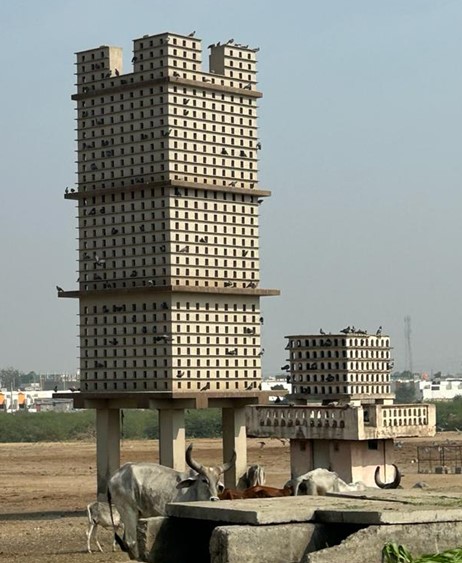Small airports are so charming. The one at Kandla is teaming with bougainvillea- rows of smiling pink and magenta as you drive out of the airport.
Huddled into a bouncy taxi, my family and I were on our much awaited trip to the Rann of Kutch this January. From the Kandla Airport, we had a one-hour drive to Bhuj.
As is always the case with me, I was keenly observing all the things that were unusual to my Delhi eyes. We crossed fields covered with grey plastic. Those turned out to be pomegranate plantations under the plastic protection. There were somber looking red flower fields which I discovered were castor seeds (oil) plants. Soon after we drove past plantations of date palms. Like a curious cat I continued to quiz the cab driver with “Bhaiya, yeh kya hai?”
As we drove along, I started noticing some colorful slim towers outside temples. My firs t thought was that they must be Deepghars or towers where diyas are lit. I have seen these very often in Goa. But on closer inspection, they seemed different – they were towers with little rooms, as it were. I asked the tired driver “bhaiyya, yeh kya tha?” Every time I pointed, we would manage to just whiz past one and he couldn’t quite understand what I was pointing towards. All I got was “temple, madam, we make them like this only.”
t thought was that they must be Deepghars or towers where diyas are lit. I have seen these very often in Goa. But on closer inspection, they seemed different – they were towers with little rooms, as it were. I asked the tired driver “bhaiyya, yeh kya tha?” Every time I pointed, we would manage to just whiz past one and he couldn’t quite understand what I was pointing towards. All I got was “temple, madam, we make them like this only.”
Next day, again, as we drove around Bhuj town, looking for farsan and mukhwas in the markets, I saw even more of these colorful towers- some taller, some shorter, some thinner, some fatter. Most of the time they were next to temples. I decided to try my luck with the new cab driver who had come for the day. He was driving slower as we were in the midst of a crowded, buzzing city. He finally spotted what I had spotted the previous day.
His response fascinated me. He said the towers were meant for birds! I looked closer and yes, I saw little birds fluttering all around them!
Some charging inside the tiny rooms and some flying out.
These were indeed birdhouses – like one big bird hostel, with their tiny rooms stacked one on top of another.
The towers were thoughtfully perched high above, so that predatory creatures, like cats, could not reach them. Also, the mouth of the rooms were so small that nothing but a bird could have flown in and out.
Next day we were driving out to the white sands and the topography became flatter and the vegetation became even sparser. Trees turned into shrubs and shrubs turned into hard dried grass. The ever faithful bird houses continued to appear – some acquiring a rather functional look, quite different from the pretty, colorful towers of the city.
This is when I realized the reason for their existence. In these arid areas where trees were lesser in population, birds would not have had many options for safe shelter and nesting.
These towers must be a boon for them- to get shade in the blistering desert heat, protection from predators at night and safety for their young ones. Some of these towers also had bird feed kept inside them. So this would also be an easy access to food.
These were such wonderful towers of kindness.
Human beings can make a difference to other creatures, just by applying their mind to innovations that make life easier in difficult regions for animal life. I came back thinking that if only each one of us could also build our own towers of kindness, by applying our mind to the betterment of the animals we share our living spaces with, the world would definitely be a happier place for everyone.
Author - Seemeen Khan